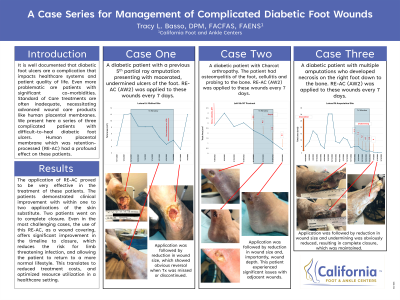Case Series/Study
(CS-014) A Case Series for Management of Complicated Diabetic Foot Wounds

Diabetic foot ulcers (DFUs) are a very common side effect of diabetes and are considered as chronic wounds that impact healthcare systems and patient quality of life. Even more problematic are patients with significant co-morbidities and a history of complications. For many patients, the standard of care is not enough to get their wound closed, necessitating advanced
wound care products like human placental membranes. These products are intended as a covering for acute and chronic wounds. We are reporting three cases of DFU patients who received placental allografts using a proprietary processing method (RE-AC).
Methods: Case one shows a diabetic patient with a previous 5th partial ray amputation presenting with macerated, undermined ulcers of the foot. RE-AC (AW2) was applied to these wounds every 7 days with the exception of one missed treatment. Case two shows a diabetic patient with Charcot arthropathy. The patient had osteomyelitis of the foot, cellulitis and probing to the bone. RE-AC (AW2) was applied to these wounds every 7 days. Case three shows a diabetic patient with multiple amputations developed necrosis on the right foot down to the bone. RE-AC (AW2) was applied to these wounds every 7 days.
Results: The application of RE-AC proved to be very effective in the treatment of these patients. The patients demonstrated clinical improvement with within one to three applications of the skin substitute. Two of the three patients went on to complete closure.
Discussion: Even in the most challenging cases, the use of this RE-AC, as a wound covering, offers significant improvement in the timeline to closure, which reduces the risk for limb threatening infection, and allowing the patient to return to a more normal lifestyle. This translates to reduced treatment costs, and optimized resource utilization in a healthcare setting.

.jpg)